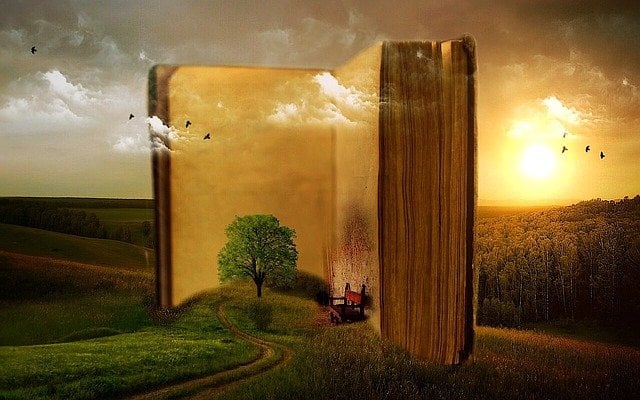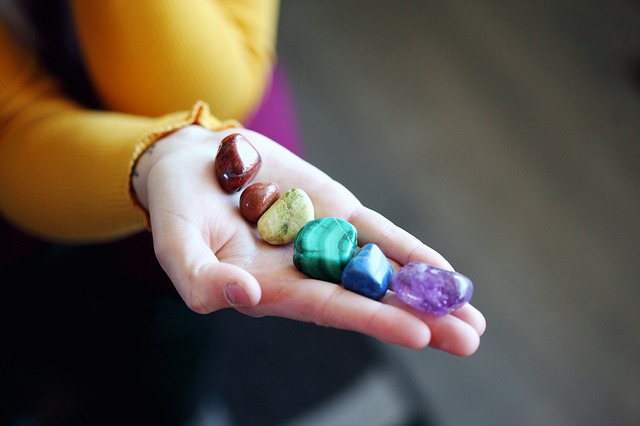An old yoga text helped me discover what CHAKRAS really are and why modern yoga misses several key elements of the original teachings on chakras
By Devendra Narayan, PhD.
The following article summarizes my research on Sat Chakra Nirupana, the seminal text on chakras from the 16th century. My opinions and interpretations presented in this article are my own, and I welcome comments, criticisms and suggestions that educate the yoga community about the true meaning of chakras and how to incorporate them into their daily yoga practice.

Image: Vectorstock.
I have been a student and practitioner of yoga for almost a decade. Though I was born and raised in India, I received my formal yoga education in the West. During my yoga teacher training, I attended workshops on Chakras that gave me an introduction to the seven energy centers in the Kundalini yoga tradition. During my studies of chakras, I learned about the rainbow colors of each chakra, the sounds and mantras that activate each chakra, and the emotions and behaviors associated with each energy center.
For several years, I did not do much with this information. It wasn't until about a year ago that I was motivated to undertake a deeper study on the meaning, purpose and practice of chakras. Through studying Prana Vidya, I realized that I did not have advanced knowledge of Nadis and Chakras, which was essential to learning and practicing the science and practice of channeling Prana, the Life Energy. So I decided to devote time to studying chakras and consciously incorporating chakra meditations into my practice.
An internet search of the word 'Chakras' will give you some idea of the word's popularity and mainstream acceptance in the Western world. I found over 1,480,000,000 results when I searched the term on Google. That's 1.48 billion results.
I was presented with an overwhelming amount of information, as you can imagine. So I started reading articles published in respected media outlets, including websites like healthline, webmd, yogapedia, yoga journal, mindbodygreen, discover magazine and Chopra foundation. Here is some of the information I gathered.
“Chakras refer to various energy centers in your body that correspond to specific nerve bundles and internal organs.” [1]
“Chakras are a spinning vortex of energy that is not seen by the human eye but can be seen, felt, and sensed with intuition.” [2]
“The chakras are the energy transducers for subtle energy.” [3]
“There are seven main chakras situated along the spine, from the base of your spine to the crown of your head.” [4]
“If a chakra becomes blocked, it can have a significant impact on physical, mental and emotional wellbeing.” [5]
“The colors of the chakras follow the ROYGBIV color sequence, beginning with red and ending with violet.” [6]
“Did you know that certain scents can help you balance your chakras?” [7]
As I browsed through those google results, I also noticed thousands of Chakra-related products including stones, crystals, essential oils, perfumes, mandala art, massage oils etc.
Despite this wealth of information, I was left wondering -
- What should I do with it?
- How can I apply it to my daily yoga practice?
- How does this information help me advance on the path of yoga?
A well-defined approach to learning and incorporating chakra meditations into my daily practice was what I was looking for. Perhaps my expectations were unrealistic since chakras are subtle. Chakra practices are mostly intuitive and experiential, and have been left open to interpretations based on the lineage or guru one follows.
Regardless, my question remained - is there a step-by-step method, a system that a beginner can learn and apply to experience these centers and benefit from chakra practices? We'll talk about it later in the article, but the resounding answer to that question is yes! Such a method does exist.
I spent many days scanning through pages after pages of internet search results, only to find myself getting more confused and frustrated as none of my questions were answered. During this time, an old saying came to my attention.
“He that would perfect himself in any art whatsoever, let him betake himself to the reading of some sure and certain work upon his art many times over. For to read many books upon your art produceth confusion rather than learning,” old saying.

Image: Pixabay.
I realized that I was looking in the wrong places. Everything I read on the internet and selected books about chakras, including one of my favorite titles, Wheels of Life: A Guide to the Chakra System by Anodea Judith, were written in the last few decades.
For my research, I needed original texts by the master meditators, teachers, and thinkers of this ancient Tantric tradition.
In my research on Chakras, I began with a 16th-century text, Sat Chakra Nirupana, written in 1577 by Swami Puranananda Yati. This text is considered an authoritative guide to chakras by many scholars. In 1918-1919, a British judge in India translated this text into English.
Sir John Woodroffe, writing under the pen name Arthur Avelon, published the first English translation of Sat Chakra Nirupana in his book The Serpent Power. Although many modern books on chakras rely on Arthur Avelon's translation of Sat Chakra Nirupana, I did not consult this English translation in my research because I wanted to refer to the original, Sanskrit version of Sat Chakra Nirupana.
But there was one problem. While I can read Sanskrit and comprehend it, I have to use a Sanskrit to English translation website for understanding whole verses, which may lead to errors in translation and interpretation. To avoid this, I decided to find a suitable translation of Sat Chakra Nirupana in Hindi that I could read and comprehend. An inherent risk of using a Hindi text is that it is a translation of the original sanskrit text. Thus, I looked for early Hindi translations from Sanskrit scholars in India.
I came across a Hindi translation by Swami Hamsa Swaroop Mahajan written in 1903. Wellcome Library in London has a hard copy of this text and has made a scanned copy available online for free [8]. Note that this Hindi translation predates Arthur Avelon's English translation of Sat Chakra Nirupana.
.png?update=2)
Credit: MS Sanskrit 391. Authored by Svami Hamsasvarupa, 1900s. Wellcome Collection. The original image has been modified for use in this article.
What is amazing about this Hindi translation are the color maps of the Chakras that were interpreted from the original Sanskrit verses of Sat Chakra Nirupana. Additionally, Swami Hansa shared insights on the anatomical locations of the seven chakras, which I find fascinating and important for beginners learning Chakra meditation.
.png)
Credit: MS Sanskrit 391. Authored by Svami Hamsasvarupa, 1900s. Wellcome Collection. The original image has been modified for use in this article.
When I translated this text into English, I was amazed to discover how different the ancient/original interpretation of Chakras was from the modern interpretation and how many details were overlooked in modern yoga. For example:
- In contrast to modern depictions/images of chakras, there is no mention that the seven chakras correspond to the seven colors of the rainbow. Although certain colors are mentioned, they do not correspond to the ROYGBIV color sequence as taught now.
- No verse mentions chakras being blocked and how to unblock them.
- No mention is made of how blocked or unblocked chakras are related to certain ailments or their cures.
- No mention is made of chakras being linked to emotional or psychological states
- No mention is made of stones, gems, crystals, or fragrances associated with each chakra
- Modern depictions and descriptions omit important details about the architecture of each chakra

Image: Pixabay.
So what are the chakras according to Yoga Upanishads and Sat Chakra Nirupana?
Yoga upanishads see chakras as holy cities within the body, and the inner journey to these holy cities through meditation is seen as an inner pilgrimage. Chakra meditation is therefore an inner pilgrimage. All major faiths and religions encourage their followers to make a pilgrimage to a holy city at least once in their lives. Hindus visit Varanasi. Christians visit Jerusalem. For Muslims visit Mecca. Buddhists go to Bodh Gaya and so on.
The Tantric practitioners demonstrated how to establish seven or more holy cities within the body. These cities were built as lotuses with 4, 6, 10, 12, 16, 2 and 1000 petals. There were then the 5 elements, sacred sounds (bija mantras), sacred symbols, and male and female deities (forms of energy) installed at each center. If you think about it, this is a fantastic method for anyone who wishes to take a pilgrimage, without having to leave their homes. Sat Chakra Nirupana does just that and describes the architecture of these holy cities as well as how to travel through them.
Considering how difficult it was in ancient times to travel to holy cities on foot, this is a wonderful concept and practice. By connecting and establishing the chakras within one's own body, this pilgrimage became less physically taxing while simultaneously helping a householder receive the divine grace and spiritual purification.
Modern interpretations of chakras have departed from this simple and profound understanding. As a result, chakras are now associated with emotions and power centers, which is a derivative teaching that I have no expertise or knowledge to determine whether are real or even useful.
Perhaps the modern interpretation of Chakras has a place in yoga today because I learned that the original descriptions of Chakras from Sat Chakra Nirupana describes many Hindu deities in these energy centers. Many Western practitioners may not feel connected to the deities, which constitutes an important part of the Chakra meditations. And perhaps for that reason, today we see a watered-down version of Chakras being presented and taught in the West.
However, it must be noted that the original masters of this system even provided a pathway for Western practitioners and those of other faiths to meditate on the Chakra. For example, in the description of the Sahasrara chakra we find that one can meditate on the one they view as their ultimate teacher (guru) in the trikona Shakti (Triangle) of Sahasrara chakra. Here you can connect with Christ, Krishna, Shakti, Allah, the supreme consciousness or the One you feel connection with. So in essence, the chakra practices are for everyone, regardless of their faith and religion.
Whether you already have a chakra meditation practice or are considering adding it to your daily spiritual routine, I invite you to spend some time studying the original teachings of this advanced yogic science of purification and enlightenment. This link contains all the articles I have written on Swami Hansa Swaroop maharaj's Hindi version of Sat Chakra Nirupana.
Personally, this journey has rewarded me with clarity on Chakras and helped me establish a step-by-step method to apply chakra meditations into my daily practice. I am eternally grateful to Sri Swami Hansa Swaroop Maharaj for blessing me and the world with his beautiful translation of Sat Chakra Nirupana.
If you resonate with this article and all the previous ones I wrote on Sat Chakra Nirupana, I invite you to join me for a LIVE masterclass on Chakras.
About the Author
Devendra Narayan is a scientist, yoga teacher, breathworker, scholar and founder of Cultivate Prana Academy. Cultivate Prana's mission is to empower modern day healers through education that integrates ancient wisdom and modern science.
Reference:
- https://www.healthline.com/health/fitness-exercise/7-chakras
- https://chopra.com/articles/what-is-a-chakra
- https://www.discovermagazine.com/health/the-science-behind-your-chakras
- https://www.webmd.com/balance/what-are-chakras
- https://www.yogapedia.com/definition/4964/chakra
- https://www.mindbodygreen.com/articles/7-chakra-colors-what-they-mean-and-why-they-matter
- https://www.yogajournal.com/yoga-101/chakras-yoga-for-beginners/chakra-candles/
- Svāmihaṃsasvarūpakr̥tam Ṣaṭcakranirūpaṇacitram : bhāṣyasamalaṃkr̥taṃ bhāṣāṭīkopetañ ca = Shatchakra niroopana chittra with bhashya and bhasha containing the pictures of the different nerves and plexuses of the human body with their full description showing the easiest method how to practise pranayam by the mental suspension of breath through meditation only ; by Shri Swami Hansa Swaroop.
-------
Copyright 2021 Cultivate Prana. All rights reserved.

